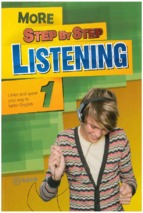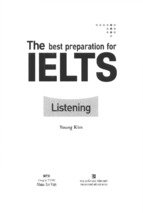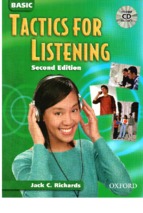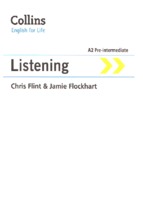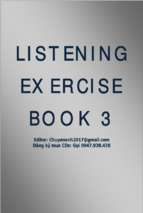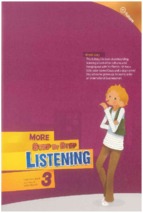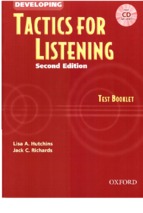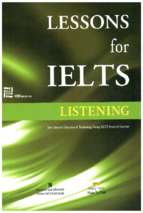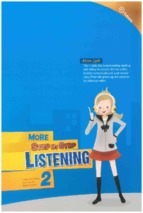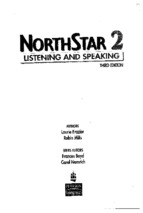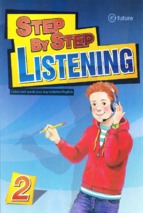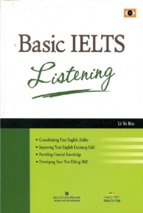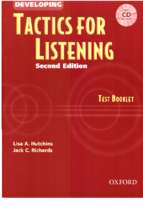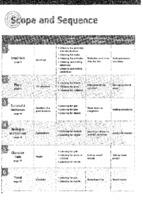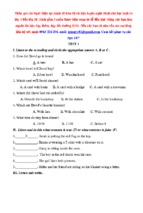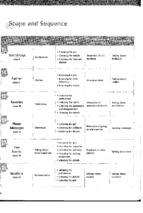học tiếng anh theo aj hope
Level 1 & 2 Mini Story Transcripts
Introduction
These are text transcripts for all the Level 1 & 2 Mini-Stories.
What about level 3? Well, Level 3 is the advanced level. I want you to focus ONLY on listening at
that level. Once you reach level 3, you need to focus all of your attention on listening.
Sometimes you won’t understand everything-- that is OK. Just keep listening-- listen to each MiniStory many times. Relax. Enjoy. You will improve.
How To Use These Text Transcripts (for level 1& 2 Mini-Stories):
1. First, try to only listen
Don’t use these text transcripts first. Try to listen to the mini-stories without the text. If you understand them, you don’t need the text-- just continue to listen.
2. Use these text transcripts only when you don’t undertand something
If you don’t understand part of a Mini-Story, read the text. This will help you identify vocabulary you
might not understand from just listening. Use a dictionary, if necessary, to find unknown words.
3. Read and Listen at the same time, a few times
Once you know all of the words and phrases in a Mini-Story, you can listen and read at the same
time. Do this a few times only
4. Just Listen again
As soon as possible, focus on just listening-- without reading. These text transcripts are only a supplement. DO NOT FOCUS ON READING-- FOCUS ON LISTENING! Most of your time should be
spent only listening to the Mini-Stories (and answering the questions). These text transcripts can
help you, but don’t use them too much :)
www.EffortlessEnglishClub.com
1. A Day For The Dead MS
Welcome to the mini story for Day of the Dead. In the mini story I will do 3 things. I will make a
statement. For example, “I arrived in Guatemala.” When you hear a statement, a sentence, you just
say, “Ah,” or, “Oh.” You need to say that. Show that you understand this is not a question. A statement is not a question, so when you hear a statement say, “Ah.” For example, “I arrive in
Guatemala.” “Ah.”
The second thing I will do is ask a question you know the answer to. For example, “Where do I
arrive?” I will stop. You say the answer. You must say the answer to every question. I say, “I arrive
in Guatemala. Where did I arrive?” You say, “Guatemala.” Easy.
And No. 3, I might ask a question you don’t know the answer to. If you don’t know the answer just
guess. Say any answer, but you must answer every question. Use your pause button if necessary.
Let’s begin. Here we go.
I arrived in Guatemala on the Day of the Dead, November 1st. Did I arrive in Guatemala? Yes.
Yes, I arrived in Guatemala. Where did I arrive? Guatemala, right. I arrived in Guatemala.
I arrived in Guatemala on the Day of the Dead, November 1st. Who arrived in Guatemala on the
Day of the Dead? Well, me – AJ. I arrived in Guatemala on the Day of the Dead, November 1st.
Did I arrive in Guatemala on November 3rd? No, no. I didn’t arrive in Guatemala on November 3rd;
I arrived in Guatemala on November 1st.
What day did I arrive in Guatemala? November 1st. I arrived in Guatemala on November 1st.
Where did I arrive on November 1st? Guatemala. I arrived in Guatemala on November 1st.
I arrived in Guatemala on the Day of the Dead, November 1st. I was curious about this holiday so I
went to the cemetery to see what was happening. Was I angry about this holiday? No, no. I wasn’t
angry about this holiday.
Was I sad about this holiday? No, no. I wasn’t sad about this holiday. I was curious about this holiday. Who was curious about this holiday? Well, I was – AJ. I was curious about this holiday.
What was I curious about? The holiday. I was curious about the holiday. Which holiday was I curious about? Which holiday was I curious about? The Day of the Dead. I was curious about the Day
of the Dead.
Was I curious about the Day of the Dead or was I curious about Christmas? No. I was curious
about the Day of the Dead of course. I was curious about the Day of the Dead so I went to the
cemetery to see what was happening. Where did I go? To the cemetery.
I went to the cemetery. Did I go to the cemetery or did I go to the airport? Easy. I went to the
cemetery. Who went to the cemetery? Well, me – AJ. I went to the cemetery.
Where did I go? To the cemetery, right. I went to the cemetery. When did I go to the cemetery?
November 1st, the Day of the Dead. I went to the cemetery on the Day of the Dead, November 1st.
www.EffortlessEnglishClub.com
Why did I go to the cemetery? Well, to see what was happening. I went to the cemetery to see
what was happening. Who went to the cemetery to see what was happening? Me – AJ – went to
the cemetery to see what was happening.
Where was the cemetery? In Guatemala. The cemetery was in Guatemala. What is the Day of the
Dead? A holiday. The Day of the Dead is a holiday.
When is the Day of the Dead? November 1st. The Day of the Dead was and is November 1st, so I
went to the cemetery on the Day of the Dead to see what was happening. What I found was quite
interesting. Was it boring? No, no. It wasn’t boring.
Was it interesting? Yes, yes. It was interesting. The cemetery was interesting. How did I feel about
the cemetery? I felt it was interesting or I thought it was interesting.
Was it boring or was it interesting? It was interesting. Of course it was interesting. What was interesting? The cemetery. The cemetery was interesting.
When was the cemetery interesting? It was interesting on the Day of the Dead, November 1st. The
atmosphere in the cemetery was like a party. Was the atmosphere very sad? No, no. The atmosphere was not sad.
The atmosphere was like a party. The atmosphere was very happy. Was the atmosphere sad or
happy? The atmosphere was happy. The atmosphere was like a party.
What was like a party? The atmosphere. The atmosphere in the cemetery was like a party. Where
was the atmosphere like a party? In the cemetery – the cemetery. The atmosphere was like a party
in the cemetery.
Was the atmosphere like a party at my house? No, no. Not at my house. The atmosphere was like
a party at the cemetery. The atmosphere was not like a party in my house. So the atmosphere was
like a party. There were people everywhere.
Families were sitting around the graves of their dead ancestors. Where were the families sitting?
Around the graves. They were sitting around the graves. Who was sitting around the graves? The
families. The families were sitting around the graves.
Were they sitting around the trees? No. They weren’t sitting around the trees. They were sitting
around the graves. So where were they sitting? Around the graves. Families were sitting around
the graves of their dead ancestors.
Were they sitting around the graves of their dead ancestors? Yes, yes. They were sitting around the
graves of their dead ancestors. Were they sitting around the graves of their friends? No, not really.
They were sitting around the graves of their dead ancestors.
Who was sitting around the graves? That’s right. Families were sitting around the graves. Whose
graves were they sitting around? Whose graves were they sitting around? Yes. Their dead ancestors’ – their ancestors’ – their ancestors’ graves.
www.EffortlessEnglishClub.com
They were sitting around the graves of their dead ancestors. Were they sitting around the graves of
their dead ancestors or the graves of their friends? Ancestors, right? They were sitting around the
graves of their dead ancestors.
They cleaned the graves and added fresh flowers. Who cleaned the graves? That’s right. The families. What did they add? They added fresh flowers.
Did they add food? No, no. They didn’t add food. Did they add money? No, no. They didn’t add
money. They added fresh flowers.
What did they clean? They cleaned the graves. Whose graves did they clean? Their ancestors’.
They cleaned their ancestors’ graves. Where did they add flowers? Where? They added flowers to
the graves.
That’s right. They cleaned the graves and added fresh flowers. Good. I walked through the cemetery and admired the beauty of all the colorful flowers. Where did I walk? Through the cemetery.
I walked through the cemetery. Did I walk through the park? No. I didn’t walk through the park. I
walked through the cemetery. Where did I walk? Through the cemetery.
Who walked through the cemetery? I did – AJ. I walked through the cemetery. Did I walk through
the cemetery or did I walk through the park? I walked through the cemetery. That’s right, and I
admired the beauty of all the colorful flowers.
Did I admire the beauty of the trees? No, no. I didn’t admire the beauty of the trees. Did I admire
the beauty of the children? No. I didn’t admire the beauty of the children.
What did I admire? The flowers. Yeah. I admired the beauty of all the colorful flowers. Who
admired the beauty of all the colorful flowers? That’s right. AJ – me – admired the beauty of all the
colorful flowers.
Where were the flowers? On the graves in the cemetery. The flowers were on the graves in the
cemetery. Were the flowers in the park? No. They weren’t in the park.
Were the flowers in my house? No. They weren’t in my house. Where were the flowers? The flowers were on the graves in the cemetery.
Where did I walk? I walked through the cemetery. When did I walk through the cemetery? Ah.
November 1st, the Day of the Dead. November 1st, the Day of the Dead, I walked through the
cemetery.
What was the cemetery like? Like a party. It was like a party. The cemetery was like a party. Was I
curious about this holiday? Yes. I was curious about this holiday.
Which holiday was I curious about? Yeah. The Day of the Dead. I was curious about the Day of
the Dead so I walked through the cemetery. There was also color in the sky because many kids
were flying kites.
Where was the color? In the sky. That’s right. In the sky. Why was there color in the sky?
www.EffortlessEnglishClub.com
Because kids were flying kites – the kites. There was color in the sky because kids were flying kites.
Who were flying kites? Kids. Kids were flying kites. Was the sky colorful or was the sky gray? The
sky was colorful.
What was colorful? They sky. The sky was colorful. Why was the sky colorful? Because kids were
flying kites.
What were the kids flying? Kites. That’s right. The kids were flying kites. Where were they flying
kites? In the cemetery. The kids were flying kites in the cemetery.
Who was flying kites in the cemetery? Kids, children. Kids were flying kites in the cemetery. Some
families were having a picnic next to the graves. We in the United States don’t do this, so some
families were having a picnic next to the graves. They ate, they drank, and they chatted together.
Did they eat? Yes. They ate. Who ate? Families, right? Of course. Families ate.
What did they eat? They ate Guatemalan food – food from Guatemala. The families ate
Guatemalan food. Did they eat American food? No, no. They didn’t eat American food.
They ate Guatemalan food. Where did they eat Guatemalan food? In the cemetery. They ate food
in the cemetery. They ate Guatemalan food in the cemetery.
They also drank in the cemetery. Did they drink water in the cemetery? No, no. What did they drink
in the cemetery? They drank beer. Who drank beer? The families. The families drank beer.
What did they eat? Guatemalan food. They ate Guatemalan food and drank beer. Did they drink
beer or did they drink water? They drank beer.
Where did they drink beer? They drank beer in the cemetery. When did they drink beer? Ah.
November 1st, the Day of the Dead they drank beer. When did they eat? They ate on November
1st, the Day of the Dead.
Did they chat together? Yes. They chatted together. Who chatted together? The families, of
course. The families chatted together. When did they chat together? Yes. November 1st, the Day
of the Dead. And people laughed and smiled.
In the United States, cemeteries are always somber. Are cemeteries happy in the United States?
No, no, no. Never. Cemeteries aren’t happy in the United States. Cemeteries are always somber,
sad, and serious.
Are cemeteries serious in the United States? Yes. Yes, they are. In the United States, cemeteries
are always somber. They are always serious. In the United States, are cemeteries somber or are
cemeteries happy?
Somber. Cemeteries are always somber in the United States. Was the cemetery somber in
Guatemala? No, no. It wasn’t somber in Guatemala. The cemetery wasn’t somber in Guatemala,
but in the United States cemeteries are always somber.
www.EffortlessEnglishClub.com
Are cemeteries always somber in Guatemala or in the United States? In the United States cemeteries are always somber. Where are cemeteries always somber? The United States. That’s right. In
the United States cemeteries are always somber.
Are they happy? No, no. They are always somber. Cemeteries in the United States are always
somber – very, very somber. We certainly never have festivals or parties next to graves.
Do we have parties next to graves? No, we don’t. We don’t have parties next to graves. Do we
ever have parties next to graves? No. We never have parties next to graves.
Do we ever have parties in restaurants? Yes, yes. We have parties in restaurants but we never
have parties next to graves. Do we ever have parties in houses? Yes, yes. We do. We have parties in houses but we never have parties next to graves.
Do we ever have parties next to graves? No, never. We never have parties next to graves. Where
do we never have parties? Next to graves. We never have parties next to graves.
Do we ever? No, never. We never have parties next to graves – not ever; never. We don’t laugh or
play music or fly kites in cemeteries either. Do we laugh in cemeteries usually? No, we don’t. We
don’t laugh in cemeteries.
Where don’t we laugh? In cemeteries. That’s right. I found that I preferred the Guatemalan
approach. Did I find that I preferred the American approach or did I find that I preferred the
Guatemalan approach? The Guatemalan approach.
I found that I preferred the Guatemalan approach. Did I find that I preferred the American approach?
No, I didn’t. I didn’t find that I preferred the American approach. I found that I preferred the
Guatemalan approach.
Which approach did I prefer? I preferred the Guatemalan approach. Did I prefer the American
approach? No. Who preferred the Guatemalan approach? Me – AJ. I preferred the Guatemalan
approach.
I found that I preferred the Guatemalan approach. I liked the way they remembered and celebrated
those who had passed away. Did they celebrate those who were alive? No, no. They didn’t celebrate those who were alive. They celebrated those who had passed away.
Did they celebrate those who had passed away or those who had become rich? They celebrated
those who had passed away. Who celebrated those who had passed away? Guatemalans, right?
Guatemalans celebrated those who had passed away.
When did they celebrate those who had passed away? On the Day of the Dead, November 1st. On
the Day of the Dead, November 1st, they celebrated those who had passed away. Who celebrated?
The Guatemalans. Guatemalan families celebrated.
Who did they celebrate? They celebrated those who had passed away. I liked that they acknowledged death instead of denying it the way Americans do. Who liked that they acknowledged death?
www.EffortlessEnglishClub.com
Me – AJ. Me – AJ. I liked that they acknowledged death.
Did they acknowledge money or did they acknowledge death? They acknowledged death. What did
they acknowledge? Death. They acknowledged death. Who acknowledged death? Guatemalans,
right? Guatemalans acknowledged death.
Did they acknowledge death or did they acknowledge money? They acknowledged death instead of
denying it. Who denies death? Americans. Americans deny death. Do Guatemalans deny death?
No, no. Not Guatemalans.
Guatemalans don’t deny death. Americans deny death. Do I like that Americans deny death? No, I
don’t. I don’t like it. I don’t like that Americans deny death but I like that there is life as well as death
in Guatemalan cemeteries. I liked that.
Did I like their cemeteries? Yes. I liked their cemeteries. What did I like? Their cemeteries –
Guatemalan cemeteries. I liked Guatemalan cemeteries.
Did I like Guatemalan cemeteries or did I like Guatemalan restaurants? I liked Guatemalan cemeteries. Whose cemeteries did I like? Guatemalans’, right? Guatemalans’ cemeteries. I liked the
Guatemalans’ cemeteries – Guatemalans’ cemeteries.
Whose cemeteries did I like? The Guatemalans’ cemeteries. I liked the Guatemalans’ cemeteries.
Guatemalans call it the Day of the Dead but it is also a day to appreciate life. That is all for this mini
story.
This was a very slow and soft mini story, so this mini story is good for beginning-level learners. For
intermediate learners, for advanced learners I use mini stories that are much faster and more difficult, but this mini story is for beginners. See you next time. Bye-bye.
www.EffortlessEnglishClub.com
1. A Kiss MS-A
Welcome to the mini story for A Kiss. In this lesson I will ask many questions. You must answer
every question. Answer every question. Pause your computer or pause your iPod, answer the
question, then play again. It’s very important – very important. Answer every question.
Let’s start A Kiss. Carlos bought a new car. Did Carlos buy a new car? Yes. Yes, of course. He
bought a new car.
Did Carlos buy an old car? No. Carlos didn’t buy an old car. Carlos bought a new car. Did Carlos
buy an old car or a new car? A new car. Carlos bought a new car.
Who bought a new car? Carlos, right? Carlos bought a new car. What did Carlos buy? A new car.
Carlos bought a new car. Was the car expensive or was the car cheap?
Ah. It was expensive. Carlos bought a very expensive car. Did Carlos buy an expensive bicycle?
No, no. He didn’t. He didn’t buy an expensive bicycle.
What did he buy? He bought an expensive car. Was the car small? No, no. It wasn’t small. He
bought a huge car – very, very big car. How big was the car? It was huge.
It was huge. Was it a huge bicycle? No, no. It wasn’t a huge bicycle. It was a huge car. Who
bought the huge car? Carlos. Carlos bought the huge car.
What color was the car? Was it yellow? No. What color was the car? Blue. It was blue. It was a
huge, blue, fast car.
While driving down the street Carlos saw a girl on a bicycle. What did he see while driving down the
street? He saw a girl on a bicycle while driving down the street. While driving down the street, did
Carlos see a dog? No. No, he didn’t.
While driving down the street Carlos saw a girl. While driving down the street did Carlos see a girl in
a car? No, no. She wasn’t in a car – not in a car. While driving down the street Carlos saw a girl
on a bicycle.
When did Carlos see a girl on a bicycle? While driving down the street, right? While driving down
the street Carlos saw a girl on a bicycle. Who saw a girl on a bicycle while he was driving down the
street? Carlos, right? Carlos saw a girl on a bicycle while he was driving down the street.
Where was Carlos driving? Driving down the street – down the street. Carlos was driving down the
street. Where was the girl? On a bicycle, right? The girl was on a bicycle, so while driving down
the street Carlos saw a girl on a bicycle.
She had long, blonde hair and was beautiful. What did she look like? Look like means was she
ugly, was she beautiful, was her hair black, brown. Look like means how does she look – her hair,
her face – so what did she look like? Well, she had long, blonde hair and she was beautiful.
What did she look like? She had long, blonde hair and she was beautiful. Did she look beautiful?
www.EffortlessEnglishClub.com
Yes, yes. She looked beautiful. Did she look ugly or did she look beautiful? She looked beautiful.
Who looked beautiful? Ah, the girl, right? The girl on the bicycle. The girl on the bicycle looked
beautiful. Carlos yelled to her.
What did he yell? He yelled, “What’s up!” Who yelled, “What’s up!”? Carlos. Carlos yelled, “What’s
up!” Did the girl yell, “What’s up!”? No. The girl didn’t yell, “What’s up!”
Carlos yelled, “What’s up!” Who did Carlos yell to? Ah, the girl. Carlos yelled to the girl. Did Carlos
yell to a boy? No. He didn’t yell to a boy. Carlos yelled to a girl.
Which girl did Carlos yell to? Which girl did Carlos yell to? Ah, the girl on the bicycle, right? He
yelled to the girl on a bicycle.
What did he yell to the girl on a bicycle? He yelled, “What’s up!” After he yelled, “What’s up!” did the
girl ignore him? Yes. Yes, she did. She ignored him.
Who ignored Carlos? The girl. The girl on the bicycle. Did Carlos ignore her? No, no. Carlos didn’t ignore her. Carlos yelled to her. She ignored him.
Did she listen to Carlos? No, she didn’t listen to Carlos. She ignored him. Did she look at Carlos?
No, she didn’t. She ignored him.
Carlos yelled again. “How’s it going?” What did he yell? “How’s it going?” Did he yell, “How’s it
going?” to the girl or to his mother? Well, of course he yelled, “How’s it going?” to the girl.
Did he yell, “How’s it going?” or did he whisper, “How’s it going?” Whisper means talk very quietly;
opposite of yell, so we have yell and whisper. I am whispering. Did Carlos whisper or did he yell,
“How’s it going?” He yelled.
Carlos yelled, “How’s it going?” He didn’t whisper, “How’s it going?” He yelled, “How’s it going?”
After he yelled, “How’s it going?” did the girl stop? No, she didn’t. The girl didn’t stop.
The girl kept going. Did the girl keep going? Yes. The girl kept going. Did she continue going?
Yes. She continued, right? She kept going.
Who kept going? The girl. The girl kept going. He yelled again, “Hey! Why won’t you talk to me? I
want to go to dinner with you. I’ll take you to an expensive restaurant.”
Where did he want to take her? To an expensive restaurant. He wanted to take her to an expensive
restaurant. This is the end of mini story A. Listen to this many times and then go to mini story B.
[End of Audio]
www.EffortlessEnglishClub.com
1. A Kiss MS-B
Hello. Welcome to mini story B. Let’s continue.
Carlos asked the girl, “Why won’t you talk to me?” Would the girl talk to him? In the past, before,
would she talk to him? No, no. She wouldn’t – she would not – talk to him.
Who would not talk to Carlos? The girl, right? The beautiful girl. The beautiful girl wouldn’t talk to
Carlos. Would the beautiful girl talk to Carlos? No. No, she wouldn’t. She wouldn’t talk to Carlos.
The beautiful girl wouldn’t talk to Carlos. Carlos wanted to go to dinner with her and he yelled, “I’ll
take you to an expensive restaurant.” What kind of restaurant did Carlos want to take the girl to?
What kind? An expensive restaurant. He wanted to take her to an expensive restaurant.
He said – this is future now – “I’ll take you – I will, I’ll, I’ll – I’ll take you to an expensive restaurant.”
Did he want to take her to a cheap restaurant? No, not to a cheap restaurant. He wanted to take
her to an expensive restaurant.
Finally the girl turned. She got off her bike and she looked at him. She said, “I don’t want to go to
dinner.” Did she want to go to dinner? No. What did she want? Ah, she wanted his car – his car.
She wanted his car. Who wanted Carlos’s car? The girl. The beautiful girl wanted Carlos’s car. Did
she want Carlos’s bicycle? No, no. She wanted his car.
She wanted Carlos’s car. Whose car did she want? She wanted Carlos’s car. Did she want
Carlos’s car or Carlos’s truck? She wanted Carlos’s car.
She said, “If you give me your car I will give you a surprise.” Ah, what did she say? She said, “If
you give me your car I will give you a surprise.” What did Carlos say? He said, “Okay!”
Who said, “Okay”? Carlos. Who did Carlos talk to – talk to? The beautiful girl. Carlos said, “Okay,”
to the beautiful girl. Carlos talked to the beautiful girl. He said, “Okay.”
After he said, “Okay,” what did he do? He jumped out of his car. Whose car did he jump out of?
His car, right? His own car. He jumped out of his car and said, “Okay!”
Then he gave her the keys and said, “Here are they keys.” What did he give her? The keys, right?
The keys to his car. Who gave the keys to the beautiful girl? Carlos. Carlos gave the keys to the
beautiful girl.
Who did Carlos give his keys to? To the beautiful girl. He gave his keys to the beautiful girl. What
did he give to her? His keys.
Did he give his house keys to the girl? No, not his house keys. Did he give his car keys to the girl?
Yes, that’s right. He gave his car keys to the girl.
Which keys did he give to the girl? Car keys, right? He gave the car keys to the girl – not his house
keys, not other keys. He gave only the car keys. Which keys did he give? That’s right. The car
keys.
www.EffortlessEnglishClub.com
He said, “Here are the keys.” The beautiful blonde took the keys. What did she take? The keys.
That’s right. She took the keys.
Who took the keys? The beautiful blonde girl. Who took the keys? The beautiful blonde girl. What
kind of girl was she? She was a beautiful blonde girl.
What kind of keys did she take? Ah, car keys, right? She took car keys. Who took the car keys?
The beautiful girl. She took the car keys and then she kissed Carlos on the cheek.
Who did she kiss on the cheek? Carlos. She kissed Carlos on the cheek. Where did she kiss
Carlos? On the cheek. She kissed Carlos on the cheek.
Did she kiss Carlos on the nose? No, she didn’t kiss Carlos on the nose. She kissed Carlos on the
cheek. Who kissed Carlos on the cheek? The beautiful girl. The beautiful girl kissed Carlos on the
cheek.
What did she do? She kissed Carlos. When did she kiss Carlos on the cheek? When did she kiss
Carlos on the cheek? After she took the keys.
After she took the keys she kissed Carlos on the cheek. Did she kiss Carlos before she took they
keys? No. She didn’t kiss Carlos before she took the keys. She kissed Carlos after she took the
keys. After she took the keys and after she kissed Carlos, what did she do? Jumped in the car.
After she kissed Carlos she jumped in the car. Did she jump onto her bicycle? No. She didn’t jump
onto her bicycle. She jumped into the car. Did she jump into the car or did she jump onto her bicycle? She jumped into the car.
Whose car did she jump into? Carlos’ – Carlos’. That ’s – Carlos’s – means it’s his car. It’s possessive. His car. Whose car is it? It’s Carlos’, so she jumped into Carlos’ car.
Did she jump into AJ’s car or Carlos’ car? She jumped into Carlos’ car. What did she do? She
jumped into Carlos’ car and then she drove away. Did she walk away? No, no. She didn’t walk
away.
Did she run away? No. She didn’t run away. She drove away. Who drove away? The beautiful
girl.
When did she drive away? She drove away after she jumped into the car – after she jumped into
the car. Carlos stood on the sidewalk. He had no car and he had no girl. He said, “That’s it? Just
a kiss on the cheek?”
Did Carlos get more? No, no, no. He said, “That’s it,” nothing more. Who said, “That’s it?” Carlos.
He said, “That’s it? Just a kiss on the cheek?” Nothing more for Carlos.
He stood on the sidewalk. Did he sit on the sidewalk? No, he didn’t sit on the sidewalk. He stood
on the sidewalk. Where did Carlos stand? Carlos stood on the sidewalk.
Did he stand on the street or did he stand on the sidewalk? Well, he stood on the sidewalk. Carlos
www.EffortlessEnglishClub.com
stood on the sidewalk. Was he happy when he stood on the sidewalk? No, no. He wasn’t happy.
He had no car and no girl. He wasn’t happy when he stood on the sidewalk. What did he say? He
said, “That’s it? Just a kiss on the cheek?” He got on her bike and rode home.
Did he ride to work? No, no. He didn’t ride to work. He rode home. Did he ride to his friend’s
house? No, he didn’t ride to his friend’s house. He rode home.
Where did he ride? Well, he rode home. Who rode home? Carlos. Carlos rode home. On what
did he ride home? On what did he ride home? On her bike, right? He rode home on her bike.
What did he ride home on? On her bike. He rode home on her bike. What did he ride home on?
He rode home on her bike.
Did he ride home in a car or did he ride home on a bike? On a bike. He rode home on a bike.
Okay. That’s it for mini story B.
[End of Audio]
www.EffortlessEnglishClub.com
1. Bubba’s Food MS-A
Hello. Welcome to mini story A for Bubba’s Food. In this lesson listen and answer every question.
Use your pause button and answer the question. Then play again. You can answer with just one
word or two words. It’s okay.
Short answers are okay. Okay. Let’s start. Let’s begin.
Sarah Smith, who lives in San Francisco, went shopping for cat food. Did Sarah, who lives in San
Francisco, go shopping for dog food? No, no. Sarah, who lives in San Francisco, didn’t go shopping for dog food. Sarah, who lives in San Francisco, went shopping for cat food. Sara went shopping for cat food.
Did Sarah, who lives in San Francisco, go shopping for dog food or cat food? Well, cat food of
course, right? Sarah, who lives in San Francisco, went shopping for cat food. Did John, who lives in
San Francisco, go shopping for cat food? No, not John. Not John. John, who lives in San
Francisco, didn’t go shopping for cat food.
Sarah, who lives in San Francisco, went shopping for cat food. Sarah is 30 years old. How old is
Sarah? Well, she’s 30. Sarah is 30 years old. Where does Sarah live? She lives in San Francisco
at 3037 Market Street.
Her address is 3037 Market Street. What is her address? Is it 3039 Market Street or 3037 Market
Street? Yes. She lives at 3037 Market Street. She has lived there since 1990.
Has Sarah lived there since 1980? No. No, not since 1980. Has she lived there since 1975? No.
She hasn’t lived there since 1975. She has lived there since 1990. Sarah has lived there since
1990.
Who has lived there since 1990? Ah, Sarah, right? Sarah has lived there since 1990. She has
lived there since when? Since 1990. Sarah has lived there since 1990.
Is Sarah married? Yes. Sarah is married. Who is she married to? Who is she married to? Ah,
John. She’s married to John.
Is Sarah married to Bill? No. She’s not married to Bill. Is she married to Jim? No. She’s not married to Jim. Is she married to Jim or is she married to John? Well, she’s married to John.
Who is she married to? She’s married to John. Who is married to John? Ah, Nancy [mistake, not
Nancy-- Sarah], right? [Sarah] is married to John. She has been married to him for 7 years.
Have they been married for 7 years or 10 years? Well, they have been married for 7 years. Who
has been married for 7 years? Sarah and John. Sarah and John have been married for 7 years.
Have they been married for 20 years? No. They have been married for 7 years.
Do they have children? Yes, they do. They have 2 children and also 1 very big cat. How old is their
son, Bob? Well, their son Bob is 5 years old. Is Bob 10 years old? No. How old is Bob? Bob is 5
www.EffortlessEnglishClub.com
years old.
Their daughter is 3. Who is their daughter? Ah, Nancy. Nancy is their daughter. Her name is
Nancy. Is their daughter Bubba? No, no, no. Their daughter (girl) is Nancy.
Who is Bubba? Ah, Bubba is their cat. Bubba is their cat. How old is Bubba? Bubba is 2. Bubba
is 2 years old.
Is Bubba a big cat or a little cat? Bubba is a big cat. Bubba is a huge cat – super big, very, very
big. Bubba is huge. Is Nancy huge? No. Nancy isn’t huge.
Is Bob huge? No. Bob isn’t huge. Is Sarah huge? No. Sarah isn’t huge. Who is huge? Ah,
Bubba. Bubba is huge.
Is Bubba a normal cat? No. He’s a huge cat – super huge cat. Bubba isn’t normal. Bubba is huge.
How much does Bubba weigh? He weighs 258 pounds.
Does he way 290 pounds? No. Does he weight 20 pounds? No. How much does he weigh? He
weighs 258 pounds. Bubba weighs 258 pounds and he’s hungry, so at 9:00 a.m. Sarah got into her
car.
Past – 9:00 a.m. maybe yesterday, maybe last year, but at 9:00 a.m. Sarah got into her car. Did she
get into her truck or did she get into her car? Well, she got into her car. Who got into her car?
Sarah. Sarah got into her car.
Did John get into his car? No. No, he didn’t. Sarah got into her car. After she got into her car,
where did Sarah drive? Where did Sarah drive? She drove to the pet store.
Sarah got into her car and drove to the pet store. Why? Why did Sarah get into her car and drive to
the pet store? Ah, to buy cat food. To buy cat food for Bubba. Who got into her car and who drove
to the pet store? Sarah of course.
Sarah got into her car and drove to the pet store. How many bags of cat food did she buy? 68.
She bought 68 bags of cat food. Who bought 68 bags of cat food? Sarah. Sarah bought 68 bags
of cat food.
Where did she buy 68 bags of cat food? At the pet store. At the pet store. She bought 68 bags of
cat food at the pet store. Did she buy 68 bags of cat food at the grocery store or at the pet store?
At the pet store. She bought 68 bags of cat food at the pet store.
How much did she pay? She paid $10.00 each plus tax. Did she pay $5.00 for each bag or $10.00
for each bag? She paid $5.00 – $5.00 for each bag. Did she get a good deal? Yes. She got a
good deal.
She got a good price. What was the normal price? The normal price was $15.00 – $15.00. Was
$15.00 the regular, normal price? Yes. $15.00 was the regular price.
www.EffortlessEnglishClub.com
Did Sarah pay $15.00 for each bag? No, no. She didn’t pay $15.00. No. She didn’t pay the regular price, so did she get a good deal? Yes. She got a good deal.
She paid only $10.00 each. She got a good deal. Did John get a good deal? No. No, not John.
Sarah got a good deal.
Okay. That is all for mini story A.
[End of Audio]
www.EffortlessEnglishClub.com
1. Bubba’s Food MS-B
Welcome to mini story B for Bubba's Food. Let's continue. Who paid $10.00 for a bag of cat food?
Sarah, right? Sarah paid $10.00 for each bag of cat food. How many bags did she buy? Well, she
bought 68 bags, right, 68. Sarah bought 68 bags of cat food for $10.00 each. Did she get a good
deal? Yes, yes she got a good deal. Sarah got a good deal. What was the regular price for each
bag? Well the regular price was $15.00. She paid $10.00. So she got a good deal. What was the
total bill? What was the total? Ah, $680.00. The total was $680.00. Did each bag cost $680.00?
No, no, no, no, no not each bag. Each bag cost $10.00 plus tax. The total was $680.00. Each bag
was $10.00. Was each bag $10.00 or $680.00? Each bag was $10.00, 10. Was the total $10.00 or
$680.00? The total was $680.00.
How did Sarah pay? Did she pay with cash or by credit card? Ah, she paid by credit card. Did she
pay with cash? No, she didn't pay with cash. Right. She didn't pay with dollars. She paid by credit
card. Who paid by credit card? Sarah. Sarah paid by credit card. Where did she pay by credit
card? Huh, at the pet store. Right. She paid by credit card at the pet store. Did Sarah pay by
credit card for cat food or for dog food? Ahh, cat food. She paid by credit card for cat food.
On her way home, Sarah stopped at a convenience store to buy milk. On her way home did she
stop at a grocery store? No, no, no, no, no not a grocery store. On her way home she stopped at a
convenience store. On her way home did Sarah stop at a grocery store or at a convenience store?
Ah, at a convenience store. On her way home Sarah stopped at a convenience store.
On her way home did Sarah stop at a convenience store to buy cat food? No, no, no, no not at the
convenience store. On her way home she didn't stop at a convenience store to buy cat food. What
did she buy at the convenience store? Ah, milk, milk. Right. On her way home Sarah stopped at a
convenience store to buy milk.
On her way to work did Sarah stop at a convenience store? No, no, no not on her way to work, on
her way home. On her way home Sarah stopped at a convenience store. Was Sarah going to work
or was Sarah going home? Ah, she was going home. On her way home Sarah stopped at a convenience store. She was going home when she stopped at a convenience store to buy milk.
Why did she buy milk? Ah, because Bubba loves milk. Does Sarah love milk? No, who loves milk?
Bubba. Bubba loves milk. How much was one gallon of milk? Well, $3.00. Right. One gallon of
milk was $3.00. Did Sarah buy one gallon? No, she didn't buy one gallon. Did she buy 50 gallons?
No, Sarah didn't buy 50 gallons. How many gallons did she buy? She bought 30 gallons.
How many gallons of water did Sarah buy? Oh, none. None, zero. She didn't buy water. Sarah
bought 30 gallons of milk. She didn't buy water. How much did Sarah pay? Well, she gave the man
$100.00 and got back $10.00. What was her total? Her total was $90.00. Right. The total was
$90.00. How much change did she get back? She got $10.00 back. Right. $10.00. Did Sarah get
$15.00 back in change? No, no she didn't get $15.00 back in change.
Did John get $10.00 back in change? No, not John. John didn't get $10.00 back in change. Who
got $10.00 back in change? Sarah or John? Sarah, right? Sarah got $10.00 back in change. Did
Sarah pay $10.00? No, no, no she paid $100.00. She got $10.00 back, returned in change. How
www.EffortlessEnglishClub.com
much change did she get back? $10.00. She got $10.00 back in change.
When did Sarah get home? She got home at 11:00 a.m. Did John get home at 11:00 a.m.? No, no
John was already home. Not John, Sarah. Sarah got home at 11:00 a.m. Did she get home at
night or in the morning? Ah, she got home in the morning, a.m., in the morning. Sarah got home at
11:00 in the morning, a.m.
Was Bubba happy when Sarah got home? Yes, Bubba was happy when Sarah got home. What
was Bubba doing when Sarah got home? Bubba was waiting at the door. Was John waiting at the
door? No, no. Was Bob waiting at the door when Sarah got home? No, no, no, no. When Sarah
got home was Nancy waiting at the door? Noooo. Who was waiting at the door when Sarah got
home? Bubba. Bubba was waiting at the door. When was Bubba waiting at the door? Ah, when
Sarah got home. 11:00 a.m., right? Bubba was waiting at the door when Sarah got home at 11:00
a.m. So 11:00 a.m. 11:00 in the morning.
Was Bubba tired? No, he wasn't tired. Was Bubba hungry? Yes, Bubba was very hungry. What did
Bubba want? Ah, Bubba wanted the cat food. Right. Bubba was very, very hungry. Was Sarah
hungry or was Bubba hungry? Bubba was hungry. When was Bubba hungry? Huh, at 11:00 a.m.
Right. Or when Sarah got home. He was hungry when Sarah got home at 11:00 a.m.
Okay, that is all for mini story B. Listen to this story. Answer each question. Use your pause button
and listen many, many, many times. Okay, see you next time.
www.EffortlessEnglishClub.com
1. Bubba’s Food MS-C
Okay, welcome to mini story C for Bubba's Food. In this lesson I will ask more questions about the
story. I will ask questions you know. Questions from the story text and I will ask some questions
you don't know. If you don't know the answer, guess. Guess. Try to think of an answer. Say something. Anything. Okay, answer all the questions. Let's start. Let's begin.
Okay. Where was Sarah from? Ah, she was from San Francisco. San Francisco. Sarah lived in
San Francisco. Was Sarah married? Yeah, Sarah was married. Of course, she was married. Who
was she married to? Yeah, that's right. She was married to John.
Where did they get married? Hmm. Where did Sarah and John get married? Did they get married
in San Francisco or did they get married in India? In India of course. They got married in India.
Who got married in India? Sarah and John got... When did they get married in India? Ah, seven
years ago. Seven years ago they got married in India. Did they get married in China? No, they didn't. They got married in India. How many people came to their wedding? How many people came
to India when they got married? Ahh, 20,000. Twenty thousand people came to India when they got
married. Wow. How many people came to India when they got married? 20,000. That's right.
Twenty thousand people came to India when they got married. And when did they get married?
Seven years ago. Where did they get married? In India. Who got married in India? Sarah and
John.
How much did they pay when they got married? Hmm. How much did they pay when they got married? Did they pay $50,000? No, no, no they didn't. Did they pay $100,000? No, no they didn't.
They paid only $2.00 when they got married. How much did they pay when they got married? Well,
$2.00. They paid only $2.00 when they got married. Who paid only $2.00 when they got married?
Sarah and John. Where did they get married? In India. How many people came to India when they
got married? Ah, 20,000, right. Twenty thousand came to India when they got married. And how
much did they pay when they got married? Only $2.00. Only $2.00.
Why did they pay only $2.00 when they got married in India seven years ago? Ah, they paid only
$2.00 because they got a great deal in India. Did they get a great deal for their marriage when they
got married? Yeah, they got a great deal when they got married. They paid only $2.00 when they
got married. It was a great deal. Right. Very cheap. After they got married they came home to San
Francisco.
When did they get Bubba? Hmm, when did they get Bubba? Ah, they got Bubba one year ago. Did
they get Bubba two years ago or one year ago? They got Bubba two years ago? How old is
Bubba? Ah, Bubba is two. Right. Bubba is two years old. When did they get Bubba? They got
Bubba one year ago. When they got Bubba was he huge? No, no he wasn't. When they got Bubba
he wasn't huge. When they got Bubba he was very small. Was he small when they got him or was
he huge when they got him? He was small. Right. One year ago Bubba was small.
One year ago how much did Bubba weigh? Ah, Bubba weighed one pound. One year ago Bubba
weighed only one pound. And now how much does Bubba weigh now? Ah, now Bubba weighs 258
pounds. Did he weigh 258 pounds one year ago? No, he didn't. He didn't weigh 258 pounds one
year ago. How much did he weigh one year ago? Ah, only one pound. One year ago he weighed
www.EffortlessEnglishClub.com
only one pound. Now he weighs 258 pounds. Wow.
Why is Bubba huge now? Ah, why? Ah, because Sarah feeds him one bag of cat food every hour.
Oh, right. He eats one bag of cat food every hour. Does Bubba eat two bags of cat food every
hour? No, no, no not two bags. Bubba eats one bag of cat food every hour. Does he eat one bag
of cat food every ten minutes? No, not every ten minutes. Does he eat one bag of cat food every
50 minutes? No, not every 50 minutes. Does he eat one bag of cat food every 60 minutes? Yes,
exactly. He eats one bag of cat food every 60 minutes, every hour. How many bags of cat food
does Bubba eat every hour? One, right. He eats one bag of cat food every hour. Who eats one
bag of cat food every hour? Bubba or Sarah? Umm, ha, ha, of course Bubba. Bubba eats one bag
of cat food every hour.
Does Bubba like milk? Ohhh, yes. Bubba loooves milk. He also drinks one gallon of milk every
hour. Does he drink two gallons of milk per hour? No, no, no not two gallons of milk per hour. Does
he drink five gallons of water per hour? No, he doesn't drink five gallons of water per hour. Does he
drink one gallon of water per hour, every hour? No, no, no not water, not water. He drinks one gallon of milk per hour. Does Bubba drink one gallon of milk per hour, every hour? Yes, yes he does.
Does he eat one bag of cat food every hour, per hour? Yes. Per hour what does Bubba eat and
drink? Ah, per hour he eats one bag of cat food and drinks one gallon of milk. Right. One bag of
cat food, one gallon of milk per hour. Per means every. Every hour, per hour is same, same meaning. So per hour Bubba eats one bag of cat food and per hour Bubba drinks one gallon of milk.
Is this expensive for Sarah or is it cheap for Sarah? Ah, expensive, expensive. Right. A lot of
money. Right. She pays a lot of money for Bubba's food and milk. It is expensive, expensive.
How much does she pay for each bag of cat food? Ah, $10.00 for each bag. And how much does
she pay for each gallon of milk? Ah, she pays $3.00 for each gallon of milk. Is her total cheap or
expensive? It's expensive, very expensive.
So now is Bubba huge or is Bubba small? Bubba is huge and Bubba is happy.
Okay, that's all for mini story C.
www.EffortlessEnglishClub.com
1. Changed MS-A
Hello. Welcome to mini story A. Mini story A for Changed. In this mini story I will ask questions you
know. Okay. Questions about the letter that you know. Let's start.
There is a woman. Where does she live? Where did she live? Let's practice past. Where did this
woman live? Well she lived in Phoenix. Alright. She lived in Phoenix. Did she live in Phoenix,
Texas? No, Phoenix isn't in Texas. Did she live in Phoenix, Arizona? Yes she did. She lived in
Phoenix, Arizona.
Who lived in Phoenix, Arizona? Ah, Grace. Alright. Her name is Grace. Grace lived in Phoenix,
Arizona. Did she live in Phoenix, Arizona or Tucson, Arizona? Well, she lived in Phoenix, Arizona.
Grace lived in Phoenix, Arizona.
Did Grace have a problem? Did Grace have a problem? Yes, she had a problem. Did she have a
problem with her children? No, no. She didn't have a problem with her children. Did she have a
problem with her mom? No. She didn't have a problem with her mom. Did she have a problem
with her husband? Yes, she had a problem with her husband.
What problem did she have with her husband? Ahh, no affection. Alright. He didn't show her any
affection. Did he show her affection? No, he didn't. He didn't show her any affection. Did he show
her a little affection? No, he didn't. He didn't show her any affection. Did he show her a lot of affection? No, no, none, zero. Her didn't show her any affection. Who didn't show her any affection?
Ah, her husband, yeah. Her husband didn't show her any affection. Did she want her husband to
show her affection? Of course, of course she did. Yes. Definitely, yes. She wanted her husband to
show her affection.
Was she happy about her husband? No, she wasn't happy. Was she sad about her husband?
Yeah, yeah. She was sad about her husband. Why was she sad about her husband? Ahh,
because he didn't show her any affection. She was sad because he didn't show her any affection.
She saw him through cancer and diabetes. Did she see him through cancer? Yes, she saw him
through cancer. Did she see him through a heart attack? No, no, no. Not a heart attack. She didn't
see him through a heart attack. She saw him through cancer and diabetes. Did he have cancer and
diabetes in the past? Yes, yes he did. In the past he had cancer and diabetes. Did she see him
through cancer and diabetes? Yes, yes she did.
Did she stay with him when he was sick? That's right. Yes, she did. She stayed with him when he
was sick. Did she leave him when he was sick? Nooo, she didn't leave him when he was sick. She
stayed with him when he was sick. When he was sick did she stay or did she leave? Ahh, she
stayed. Right. She's a great wife. She stayed with him when he was sick.
How long have they been married? Hmm, ahh, 39 years. Right. She said, "39 years." They have
been married 39 years. Have they been married 37 years? Nooo, they haven't been married 37
years. Have they been married 37 years or have they been married 39 years? That's right 39.
They have been married 39 years. Have they been married 39 years? Yes, exactly. They have
been married 39 years.
www.EffortlessEnglishClub.com
- Xem thêm -



